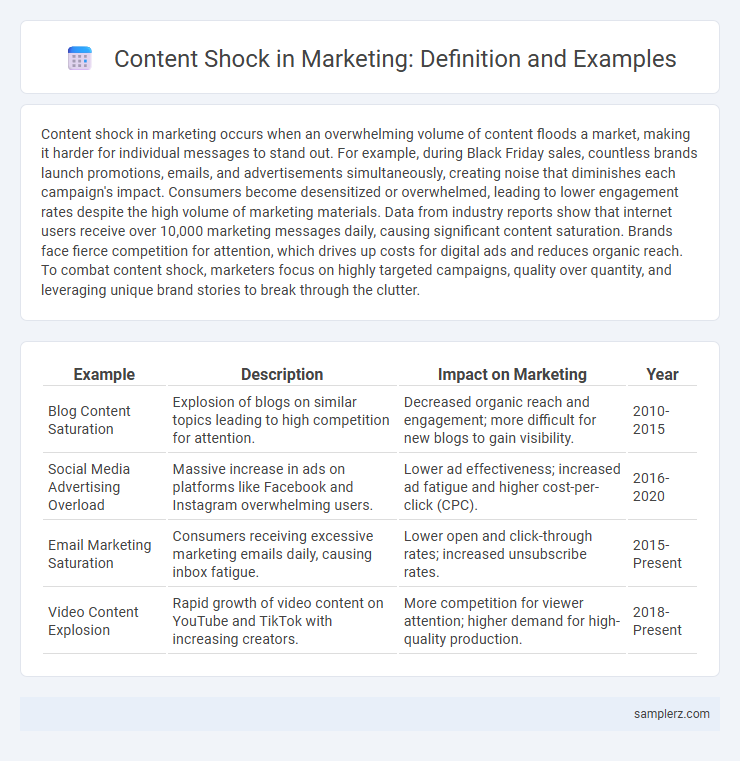Content shock in marketing occurs when an overwhelming volume of content floods a market, making it harder for individual messages to stand out. For example, during Black Friday sales, countless brands launch promotions, emails, and advertisements simultaneously, creating noise that diminishes each campaign's impact. Consumers become desensitized or overwhelmed, leading to lower engagement rates despite the high volume of marketing materials. Data from industry reports show that internet users receive over 10,000 marketing messages daily, causing significant content saturation. Brands face fierce competition for attention, which drives up costs for digital ads and reduces organic reach. To combat content shock, marketers focus on highly targeted campaigns, quality over quantity, and leveraging unique brand stories to break through the clutter.
Table of Comparison
| Example | Description | Impact on Marketing | Year |
|---|---|---|---|
| Blog Content Saturation | Explosion of blogs on similar topics leading to high competition for attention. | Decreased organic reach and engagement; more difficult for new blogs to gain visibility. | 2010-2015 |
| Social Media Advertising Overload | Massive increase in ads on platforms like Facebook and Instagram overwhelming users. | Lower ad effectiveness; increased ad fatigue and higher cost-per-click (CPC). | 2016-2020 |
| Email Marketing Saturation | Consumers receiving excessive marketing emails daily, causing inbox fatigue. | Lower open and click-through rates; increased unsubscribe rates. | 2015-Present |
| Video Content Explosion | Rapid growth of video content on YouTube and TikTok with increasing creators. | More competition for viewer attention; higher demand for high-quality production. | 2018-Present |
Understanding Content Shock in Modern Marketing
Content shock in modern marketing occurs when the volume of information available to consumers surpasses their capacity to consume it, leading to decreased engagement and diminished returns on content investment. Brands face significant challenges in standing out as digital channels become saturated with competing messages, requiring marketers to prioritize quality, relevance, and strategic distribution. Understanding content shock helps marketers optimize content creation efforts by focusing on targeted audiences and leveraging data analytics to deliver personalized experiences that cut through the noise.
The Rise of Content Oversaturation
The rise of content oversaturation has led to content shock, where audiences are overwhelmed by the vast volume of marketing materials flooding digital platforms daily. Brands struggle to capture attention as social media, blogs, and videos multiply exponentially, causing diminishing returns on traditional content strategies. Marketers must now prioritize quality, relevance, and targeted distribution to break through the noise and engage consumers effectively.
How Content Shock Affects Consumer Behavior
Content shock overwhelms consumers with excessive marketing messages, leading to decreased attention and engagement. This saturation triggers decision fatigue, causing consumers to ignore or actively avoid branded content. Marketers must adapt by creating high-quality, targeted content to break through the noise and retain consumer interest.
Real-World Examples of Content Shock
Content shock in marketing is evident in the overwhelming volume of daily blog posts, such as the over 7 million articles published on WordPress sites alone each day, which saturates audiences and diminishes individual content visibility. Companies like HubSpot have reported that despite increasing content output, their organic reach and engagement rates plateaued, illustrating the challenge of standing out amid content overload. This saturation forces marketers to adopt highly targeted, value-driven strategies to cut through the noise and capture consumer attention effectively.
Case Study: Brands Struggling with Content Overload
Brands like Coca-Cola and Pepsi have faced content shock as their extensive content libraries saturate consumer attention, leading to diminished engagement rates. Case studies reveal that both companies experience reduced ROI on content marketing due to overwhelming volume, causing audience fatigue and lower conversion rates. Strategic content curation and targeted personalization emerge as essential solutions to combat the negative effects of content overload in competitive markets.
Content Shock and Declining Engagement Rates
Content Shock occurs when the volume of marketing content exceeds audience consumption capacity, leading to increased competition and declining engagement rates. Brands face diminishing returns as users become overwhelmed, causing click-through rates and social media interactions to drop significantly. This phenomenon forces marketers to prioritize quality over quantity, leveraging targeted strategies and personalized messaging to capture audience attention effectively.
Content Fatigue: Impact on Digital Campaigns
Content fatigue occurs when audiences are overwhelmed by excessive digital marketing messages, leading to decreased engagement and lower conversion rates. Studies reveal that consumers exposed to over 500 marketing impressions daily exhibit a significant drop in attention spans, causing diminishing returns on content investments. Marketers must adapt strategies by prioritizing high-quality, targeted content to combat audience burnout and maintain campaign effectiveness.
Lessons Learned from Content Shock Incidents
Content shock in marketing occurs when oversaturated digital channels reduce audience engagement despite increased content production, as seen with major brands on platforms like Facebook experiencing declining organic reach. Lessons learned emphasize the importance of prioritizing quality over quantity, implementing strategic content distribution, and leveraging targeted audience insights to maintain relevance. Marketers adapt by investing in unique, value-driven content and diversifying channels to combat content fatigue and ensure sustained user interaction.
Strategies Brands Used to Overcome Content Shock
Brands facing content shock increase investment in high-quality, targeted content to stand out in saturated markets. Leveraging data analytics, companies personalize messaging, ensuring relevance and engagement with specific audience segments. Innovative formats such as interactive videos and immersive experiences drive stronger customer connections, overcoming overwhelming content volumes.
Key Takeaways for Marketers Facing Content Shock
Content shock occurs when the volume of available marketing content overwhelms audiences, leading to diminished engagement and reduced content effectiveness. Marketers must prioritize quality over quantity by creating highly targeted, valuable, and original content that resonates with specific audience segments. Leveraging data analytics to identify content gaps and focusing on unique storytelling can help break through the noise and maintain audience attention in saturated markets.

example of content shock in marketing Infographic
 samplerz.com
samplerz.com